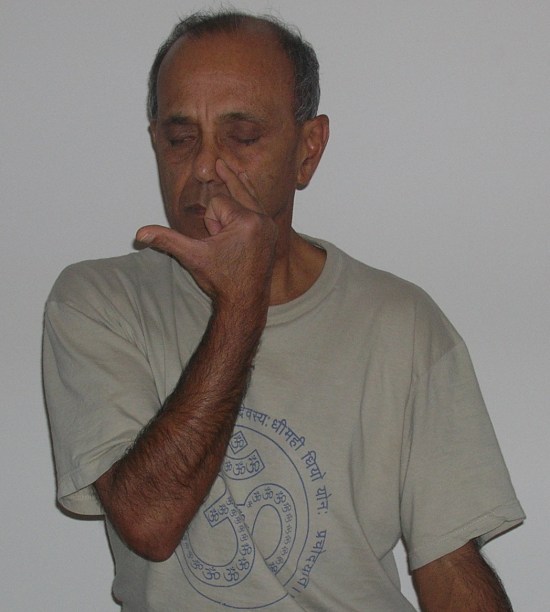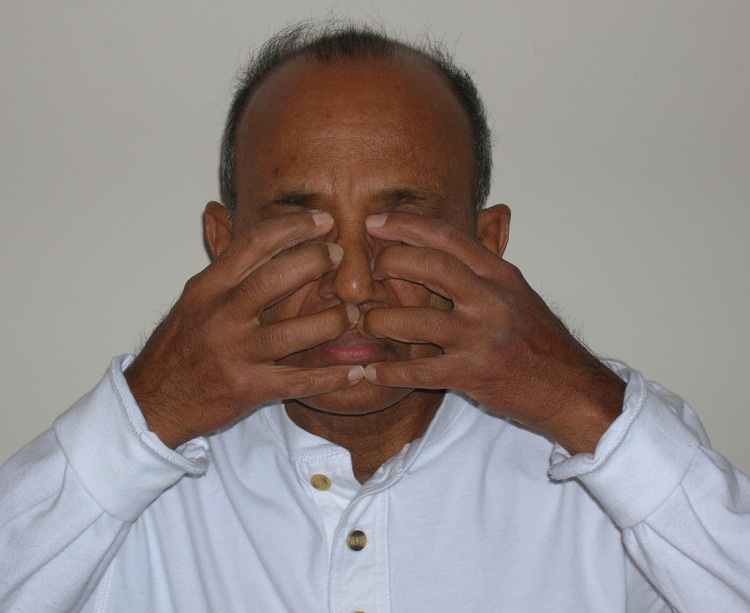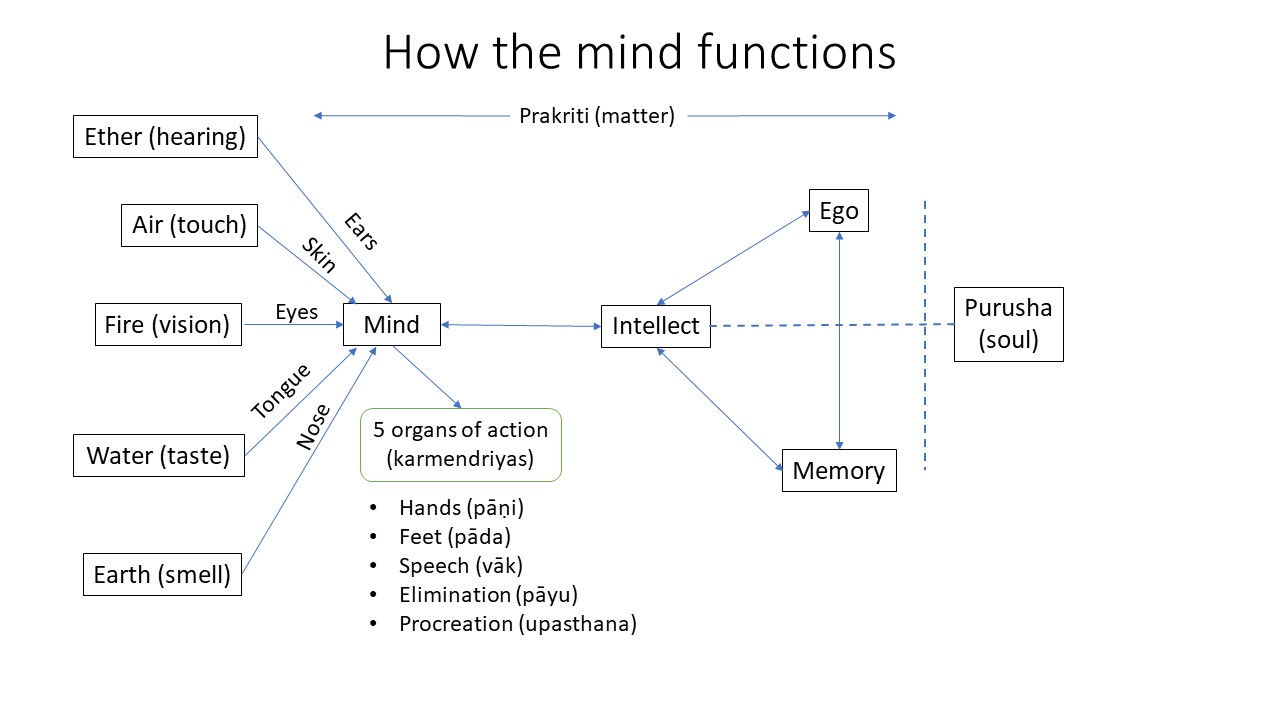|
|
If you recall, in the Kapalabhati pranayama, the emphasis is only on exhalation which is forced, short and brisk. The inhalation is passive and natural. During exhalation we also force the belly in toward the spine in a quick movement. In contrast, in the Bhastrika pranayama, both inhalation and exhalation are forced. Moreover, movement of the belly along with each breath is an optional variation.
‘Bhastrika’ is a Sanskrit word for the bellows – a device for producing a strong current of air that was used to fan fire in the old days. In this pranayama, the lungs are moved with movements that resemble the bellows.
Continue reading »
Up until recently, Intelligence Quotient (IQ) was considered to be the best indicator of a person’s intelligence and consequently their success in personal and professional life. In the last few years, however, the concepts of Emotional Intelligence (EI) and Emotional Quotient (EQ) have become popular topics of discussion and are now being considered a more accurate indicator of a person’s performance at a professional level.
Emotional intelligence (EI) is a form of social intelligence that involves the ability to monitor one’s own and others’ feelings and emotions, to discriminate between them, and to use this information to guide one’s thinking and action (Salovey & Mayer, 1990, p 5). Goleman identifies five components of EI: self-awareness, self-regulation, motivation, empathy and social skill.
Because of the wealth of information available online as well as in many books, I do not plan to spend any time discussing the details of EI/EQ. However, I would like to discuss how yoga can help us get in touch with our own emotions and how to develop a better control over them.
Continue reading »
Yes, we are all set for the next 21-day yoga challenge. Are you ready for this exciting and one of the most memorable yoga experiences of your life? Take the challenge and be transformed. Start the New Year on a truly healthy note. Here are the particulars:
- When: Sunday, January 9 – Saturday, January 29, 2011. I can accommodate a maximum of 15 people.
- Time: 6:00 AM – 7:30 AM
- Where: Kalasrishti – 3000 Bearcat Way, Suite 112, Morrisville, NC 27513 (off Aviation Parkway – the studio is located on the back side of the last building in the complex)
- Commitment: A Â firm commitment to complete the program without missing a day (except in an emergency)
- Cost: $115
Please contact me if you would like to participate.
Get all the details here…
The word "yoga" is derived from the Sanskrit root word "yuj" which, depending upon the context, can have several different meanings. See here for a list of nearly 40 different meanings of the word "yoga" from the dictionary by Monier Williams (type the word "yoga" in the search box provided).
As you are perhaps aware that the most commonly understood meaning of yoga is "union". Most people would say that "yoga is the union of body, mind and soul". But, is that really the case?
Most of us who practice yoga follow the philosophy of yoga as given by Patanjali in his Yoga Sutras. Let us try to understand the meaning of "yoga" in the context of Yoga Sutras. Patanjali defines yoga as -‘yogash-chitta-vritti-nirodhah" which means that yoga is to still the mind’s fluctuations, which is termed as the state of ‘samadhi’. And the purpose of stilling the mind is to realize the non-connectedness between the soul (atman) and the material aspect of our being – body, mind and intellect. The word for this final state used in the yoga sutras is "kaivalya" which implies understanding that the soul is separate from the mind-body complex. In fact, Patanjanli clearly says that the main cause of our suffering is that we identify the soul with our mind and body. See sutras 2.23 thru 2.25 for more details. So, to reiterate, in the context of the yoga sutras, the word yoga does NOT mean union but in fact it means that we recognize the non-union of purusha (soul) and prakriti (body/mind etc.).
Yoga Sutras of Patanjali, which is one of the six ‘darshanas’ or Indian systems of philosophy, is a dualistic philosophy. Patanjali has taken some of the basic tenets from Samkhya and built the philosophy, psychology and methodology of yoga based on those Samkhya principles. The key principle there is the presence of two independent entities Purusha and Prakriti. In common parlance, Purusha can be termed the soul and Prakriti the material aspect of this creation which includes our body/mind complex. Since these two are separate and independent entities, there is no question of their union. In fact, the false identification of purusha with prakriti is the root cause of all human sufferings. As mentioned earlier, the goal of yoga is "kaivalyam" which is freedom of purusha from prakriti. I would like to emphasize that I am presenting the view which is based on the concepts in yoga sutras.
As mentioned above, the word "yoga" has different meanings depending upon the context in which it is used. For example, in Bhagavad Gita, each of the 18 chapters has a name ending in "yoga". The first chapter, for example, is titled, "Arjuna-vishada-yoga" (Yoga of Arjun’s grief). In none of those 18 chapters, the word "yoga" is used in the meaning of "union". The terms Bhakti Yoga, Jnana Yoga, Karma Yoga etc are used frequently in BG to indicate different approaches to life in pursuit of the final goal of liberation.
In the Vedanta philosophy also, the concept is "oneness" not "union". Two of the most important statements in the Upanishads, called Mahavakyas (great sentences) are – "aham brahmasmi" ("I AM Brahman" and NOT "I am united with Brahman") and "tat tvam asi" ("you ARE that" and NOT "you are united with that"). In fact, in the Vedantic philosophy, all is ONE, termed ‘brahman’. When all is ONE, there is no question of UNION. When we talk of UNION, we are already talking of separation of two things which need to be united. In Vedanta, no such separation exists.
To summarize, then, in the context of Yoga Sutras, the word "yoga" does NOT mean "union". The word "yoga" must be understood in the context in which it is used. We want to definitely stay away from blindly saying that "yoga is the union of body, mind and soul".
I would love to hear your thoughts. Please provide your comments below.

We are all familiar with instances when our emotions can control the breathing rhythm. For example, when we are very angry or agitated, our breathing is very uneven, fast and shallow. When we are very sad, we breathe uneven, sobbing breaths. When we are calm or engrossed in some pleasant activity, like listening to some soulful music, our breathing is very gentle, even and soft. When we are trying to thread a needle, we naturally suspend our breathing as we attempt to move the thread through the hole. These examples demonstrate that our breathing pattern is a good indicator of the state of the mind that we are experiencing at a given time.
Continue reading »
In a recent article titled "Hindu Group Stirs a Debate Over Yoga’s Soul", New York Times has brought into focus the question concerning the origins of yoga which is being hotly debated on various blogs and newspaper columns. The article highlights the recent "Take Back Yoga" campaign launched by the Hindu American Foundation (HAF).
Continue reading »

The word ‘bhramari’ (भ्रामरी) refers to the humming sound made by a ‘bhramara’ (a bumble bee in Sanskrit). The Bhramari Pranayama consists in making a deep, soft humming bee-like sound while exhaling.
Because Bhramari Pranayama has a very calming effect on the nerves and the mind, it is usually practiced as a prelude to meditation. As a part of the pranayama routine, it should be practiced at the end of other pranayama practices, usually after the alternate nostril breathing (naadi shuddhi), prior to getting ready for meditation.
Continue reading »
– by Kailasam
The Buddha diagnosed the symptoms of the Human Condition ( anxiety over birth, death, old age, and disease) and hypothesized that attachment was the cause. Sage Pathanjali pursues the diagnosis even further and proposes that the root cause is the lack of true knowledge ( agnanam). This lack is at the level of day to day life in the form of misapprehension of the true nature of the phenomenal universe and its activities as well as at the level of not knowing the true nature of our “Selfâ€.
The antidote is, again, at two different levels; a) clearing the mind of biases and prejudices of all kinds to be able to reflect without distortion what is sensed. Ordinarily, we do not have unmediated access to the phenomenal world which includes ourselves. Our knowledge is based on processed and interpreted information. Until and unless the processing and interpreting is curbed, we can not know anything for what it is. b) The Truth and Its Operating Principle ( Satyam/Riti) which is at the core of the beginning, during, and the end of all can be approached and experienced by a clear mind and from that state of experiential knowledge one can become conscious of consciousness itself.
Continue reading »
[Recipe provided by Anna Troupe (thanks Anna!)]
(adapted from a recipe from Raw Family Signature Dishes)
Ingredients
WET PART: (blender)
- 2 cups zucchini (skin-on)
- 2 cups apples
- 1 c. dates
- 4 tbsp. raw agave nectar (I use vanilla creme stevia)
- ¼ cup lemon juice (about 1 lemon)
- 1 tsp. vanilla
Blend all the wet ingredients thoroughly to a creamy consistency.
Continue reading »

4 functions of mind
In his Yoga Sutras, Patanjali has defined yoga as “control of the fluctuations of the mind-field” (योगश्चित्त-वृत्ति-निरोधः) – sutra 1.2. In order to learn how to control the mind-field, it will be helpful to understand what this mind-field is and how the mind functions. In our ancient literature, especially the Vedantic texts, this mind-field is given the name “Antahakarana” (the inner instrument). For ease of understanding, this ‘antahakarana’ is considered to be composed of these four components:
- Cognitive mind (manas – मनस्): this is the thinking aspect of the mind; it carries out perception and cognition through the five senses; it does the willing, wishing, desiring; it has the emotions etc. The manas interacts with the intellect and the outside world through the five senses.
- Intellect (buddhi – बुद्धि): This is the decision-making element in the mind-field. It discriminates between all the dualities – good/bad, hot/cold, honor/dishonor etc. and helps us make ‘intelligent’ decisions. It interacts with the ego and the chitta.
- Ego (ahamkara – अहंकार): Ego or ahamkara, literally the I-maker, is the one that identifies the Self with the mind-body complex and gives me the notion of my individuality. It puts labels on everything that we perceive, whether through the five senses, or something pulled from the memory – labels like good/bad, ugly/handsome, father, mother, rich, poor etc. It is the ego which has all the likes and dislikes. It interacts with the chitta and the intellect.
- Storehouse of memories and past impressions (chitta – चित्त): This is where all the memories, past impressions, hidden desires etc are stored. Every action that we do, every thought that occurs in the mind, creates an impression which gets stored in the chitta. These impressions lay in the sub-conscious until a suitable trigger pulls them out and brings them as active content of the mind, called ‘pratyaya’ by Patanjali.
How does it all function together?
Let us take an example which will help us understand how the mind functions. Picture this scenario:
You walk into the kitchen and perceive a smell. The smell leads you to the refrigerator. You open the refrigerator and notice that the smell is coming from a piece of cake. The mind, at this point, is receiving input from the sense of smell, the sense of sight; you touch the cake to find its texture. You even take a small sample and put it in your mouth to get a taste of it. Here is how the decision-making process proceeds.
The mind feeds all this sensual information to the intellect. The intellect has to make a decision what to do with this information. The most obvious choice it has to make is whether to eat the cake or not. The intellect is unable to make an independent decision as it is conditioned to always consult with the ego before making any decision. So it approaches the ego for advise. The ego digs into the memory and pulls out all the information related to this cake from a previous experience. It determines that in the past the experience of eating this cake was a most pleasurable one – the taste, smell, the texture etc – all was just heavenly! So, the ego advises the intellect to go ahead and order the mind to take necessary actions to eat the cake. The intellect puts the final decision on hold for a moment and decides to make some independent investigation of its own. It goes and digs into a different section of the memory and finds more information that needs looking into. It finds out that just a couple of days ago, during a visit to the family doctor, the recent blood work showed high levels of cholesterol in the system. The doctor’s strong advise was to avoid all foods rich in sugar and fat. Now the intellect is in a dilemma as to what the appropriate decision should be since it believes that based on doctor’s advise this cake needs to be avoided. It, however, again goes back to the ego with this new information for more advise. The ego has already labeled this cake as the ‘best thing in the world’. It counter-argues with the intellect saying that one piece of cake cannot kill anyone; after all it is just one piece. Just go ahead and eat it. Poor intellect, being deeply conditioned to follow the advise of the ego, does as commanded.
This was one single instance where the intellect was completely subdued by the ego. Similar situations happen every single day and every day it is the same advise coming from the ego- one piece of this junk food or that junk food cannot harm anyone. We all know the result of this type of behavior. This is the behavior that eventually causes physical ailments like heart problems, diabetes and hypertension etc and even all the mental stresses and strains which manifest as further physical and emotional ailments – depression, anxiety, negative emotions like anger, greed, jealousy etc.
Identifying the problem
Once we study this scenario in detail, we realize that the main problem is the fact that the intellect is completely bound to the ego and is unable to make independent decisions. So, somehow we have to learn how to disengage the intellect from the ego. This is where we turn to Patanjali who has provided us with all the tools that we need to use so that the intellect becomes sharp as a razor’s edge, pure as a pure crystal/gem. These tools are given in the form of the eight limbs of yoga, called Ashtanga Yoga. It is by a regular and dedicated practice of these eight limbs that we can develop a sharp intellect and free ourselves from the clutches of the ego. Once we can do that, then we have a better chance of understanding our true reality which is to recognize that we are in fact nothing but pure consciousness and have no real connection with the entire material aspect of our being which includes this mind-body complex.
After you study the above scenario, try to relate it to various situations in your daily life and see if you can identify the involvement of ego in your day-to-day actions. This will slowly develop a better awareness of the functioning of the mind and then you can take adequate measures to avoid similar involvement of the ego in future situations.
I would love to hear your feedback. Please provide your comments in the comment box below.
|
Video DVD
Yoga with Subhash (asana and pranayama)
- Basic asana sequence (~50 min) ($18)
- Pranayama/Meditation (~35 min) ($12)
- Set of above two ($25)
Video recording of special programs offered in the past
(Links to YouTube videos will be provided)
- 21-day yoga immersion - $40
- 7-day hip opening intensive - $20
- 14-day meditation intensive - $30
- 14-day pranayama intensive - $30
- 7-day hamstring/quad intensive - $20
- 14-day Level 2 yoga intensive - $35
Payment options:
- cash, check, Zelle (use subhashmittal@gmail.com) or Venmo (use 9199269717)
- PayPal (go to bottom of page) (add $5 to the fee listed above)
Please contact me if you would like to buy.
|



Recent Comments